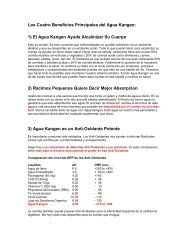ACID-ALKALINE BALANCE: ROLE IN CHRONIC ... - My Kangen Tools
ACID-ALKALINE BALANCE: ROLE IN CHRONIC ... - My Kangen Tools
ACID-ALKALINE BALANCE: ROLE IN CHRONIC ... - My Kangen Tools
Create successful ePaper yourself
Turn your PDF publications into a flip-book with our unique Google optimized e-Paper software.
Tanner and Tanner: Citrate treatment in PKD rats 1867<br />
Fig. 4. Summary of effects of various treatments<br />
on GFR in three-month-old normal rats<br />
() and rats with PKD ( ). The data from<br />
the rats treated with KCitr or tap water are<br />
from our previous study [7]. GFR was preserved<br />
in the rats with PKD, which consumed<br />
solutions of KCitr (K 3 citrate citric acid),<br />
Na 3 citrate citric acid, or K 3 citrate alone,<br />
but was about half of normal in the rats that<br />
drank tap water or the (NH 4 ) 2 citrate citric<br />
acid solution.<br />
undertaking these experiments that plasma and kidney<br />
cortex citrate concentrations are elevated in untreated<br />
rats with PKD, we might have been dissuaded from administering<br />
additional citrate. These surprising results bolster<br />
our conclusion (discussed later in this article) that<br />
the alkalinizing effect of citrate, rather than some other<br />
attribute of citrate, underlies the success of citrate therapy.<br />
Data on citrate handling in patients with PKD are<br />
limited. In one study of PKD patients with nephrolithiasis,<br />
an abnormally low rate of citrate excretion was seen<br />
in 67% of the patients, but this could be due an abnor-<br />
mally low urine pH [26]. Renal citrate handling by PKD<br />
patients, as far as we know, has not been systematically<br />
studied.<br />
Renal handling of ammonia<br />
The suggestion has been made that increased intrare-<br />
nal levels of ammonia might contribute to tubulointerstitial<br />
injury in chronic renal diseases [27, 28], including<br />
PKD [9, 10, 29]. Torres et al reported an elevated ammonia<br />
level in human cyst fluid, but whether the fluid was<br />
derived from proximal or distal cysts is not clear [10].<br />
Also, cyst fluid total ammonia levels may not reflect<br />
interstitial ammonia levels, since fluid within tubules or<br />
cysts is generally more acidic and ammonia is trapped<br />
as NH 4 . In the present study, we detected no increase<br />
in arterial or renal vein total ammonia concentrations<br />
or in cortical tissue P NH3 in rats with PKD (Table 4).<br />
Therefore, our data do not support the hypothesis that<br />
elevated intrarenal ammonia levels are responsible for<br />
kidney damage in this disease.<br />
Urinary ammonia production and excretion were below<br />
normal in cystic rat kidneys. Preuss et al demon-<br />
strated earlier that ammonia excretion was reduced in<br />
patients with PKD and postulated that this was secondary<br />
to decreased renal ammonia production, as we found<br />
in the rat with PKD (Table 4) [30]. Impaired urinary<br />
excretion of ammonia could contribute to the metabolic<br />
acidosis in untreated rats with PKD (Table 2).<br />
Calcium and citrate<br />
We hypothesized that citrate administration might ex-<br />
ert its beneficial effect by preventing precipitation of<br />
calcium salts and lowering tissue calcium levels. We<br />
found, however, that KCitr treatment for five months<br />
led to higher levels of calcium in the kidney, even in<br />
normal rats (Table 5). Accumulation of calcium in the<br />
rat kidney with citrate intake has been observed before<br />
[31] and appears to be a consequence of the elevated<br />
urine pH. Deposition of calcium salts in kidney tissue<br />
occurs in rats [2] and patients [26] with PKD, and can<br />
lead to tissue damage and ischemia. In our study, treat-<br />
ment with KCitr produced only a modest nephrocal-<br />
cinosis that did not appear to progress; normal rats on<br />
KCitr for 20 months had tissue calcium levels the same<br />
as in six-month-old rats (data not shown). Nevertheless,<br />
the modest elevation in tissue calcium suggests that<br />
KCitr does not ameliorate PKD by lowering tissue cal-<br />
cium levels.<br />
Citrate complexes calcium in the urine and inhibits<br />
the formation of renal stones [23]. Torres et al found<br />
that giving high concentrations of another alkalinizing<br />
agent, potassium bicarbonate (200 to 300 mmol/L), caused<br />
extensive precipitation of calcium phosphate in medul-<br />
lary collecting ducts [9]. Citrate may be a safer compound<br />
to administer than other agents that alkalinize the urine.<br />
Alkalinizing effect of citrate<br />
Data in the present study strongly suggest that the<br />
beneficial effect of treatment with KCitr is a consequence<br />
of the citrate ion and its oxidation in the body to bicarbonate<br />
(alkalinizing effect). Several observations confirm<br />
an alkalinizing effect of citrate. In rats with PKD,<br />
KCitr administration resulted in an arterial blood pH of<br />
7.39, compared with 7.30 in water-drinking rats (Table<br />
2). Urine pH was significantly more alkaline after the<br />
administration of KCitr in both normal rats and rats<br />
with PKD (Table 2). Renal ammonia synthesis, which is



